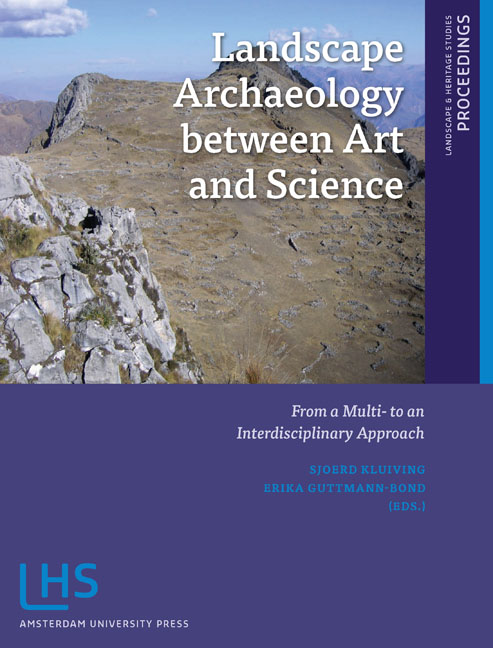Book contents
- Frontmatter
- Contents
- Preface
- Introduction: LAC2010: First International Landscape Archaeology Conference
- THEME 1 HOW DID LANDSCAPE CHANGE?
- THEME II IMPROVING TEMPORAL, CHRONOLOGICAL AND TRANSFORMATIONAL FRAMEWORKS
- THEME III LINKING LANDSCAPES OF LOWLANDS TO MOUNTAINOUS AREAS
- THEME IV APPLYING CONCEPTS OF SCALE
- THEME V NEW DIRECTIONS IN DIGITAL PROSPECTION AND MODELLING TECHNIQUES
- THEME VI HOW WILL LANDSCAPE ARCHAEOLOGY DEVELOP IN THE FUTURE?
- Miscellaneous Endmatter
5.4 - Mapping the Probability of settlement location for the Malia-Lasithi Region (Crete, Greece) During the Minoan Protopalatial period
Published online by Cambridge University Press: 21 January 2021
- Frontmatter
- Contents
- Preface
- Introduction: LAC2010: First International Landscape Archaeology Conference
- THEME 1 HOW DID LANDSCAPE CHANGE?
- THEME II IMPROVING TEMPORAL, CHRONOLOGICAL AND TRANSFORMATIONAL FRAMEWORKS
- THEME III LINKING LANDSCAPES OF LOWLANDS TO MOUNTAINOUS AREAS
- THEME IV APPLYING CONCEPTS OF SCALE
- THEME V NEW DIRECTIONS IN DIGITAL PROSPECTION AND MODELLING TECHNIQUES
- THEME VI HOW WILL LANDSCAPE ARCHAEOLOGY DEVELOP IN THE FUTURE?
- Miscellaneous Endmatter
Summary
ABSTRACT
The current study considers a mixed environmental/historical statistical model to establish a probability map for settlement locations in Crete's Malia-Lasithi region during the Minoan Protopalatial period. The work represents the continuation of previous research that focused on site location choices during the Protopalatial and whereby a comparison was made between the performances of a purely environmental over a mixed environmental/historical model. Statistical modelling consisted of fitting a logistic regression model using a Deletion/Substitution/Addition (DSA) algorithm for model selection. Model uncertainty was assessed through calculation of confidence intervals at the 95% confidence level and the results are presented as probability maps that show upper and lower interval endpoints for the study area. Assessment of the model's predictive performance, on both the study area and on an independent validation area, indicates that the model is able to capture some underlying structure that determines preferences for site locations. Moreover there is a general agreement between the generated settlement probability map and many of the existing published survey results. The results obtained demonstrate the usefulness of the modeling approach and we expect that the existing model can be further improved in the future by incorporating more survey data.
KEYWORDS
Minoan, Protopalatial, Predictive Modelling, Logistic Regression, DSA algorithm
INTRODUCTION
Archaeological predictive modelling (APM) is often used with the underlying meaning of predictive modelling applied to heritage management. For this reason predictive modelling is the focus of much controversy and debate. The main issue of this debate is whether predictive modelling should be used as a tool in establishing a heritage managing policy. The purpose of this paper is not to enter such a debate but rather to emphasise that the role of predictive modelling is not limited to heritage management.
Foremost predictive modelling provides a systematic approach to understand settlement location choices of past populations. With the use of a good theoretical framework based upon the existing archaeological data it then becomes possible to pursue appropriate statistical modelling. A major benefit of a statistical model is that it can be used to both systematically establish the major factors determining site location and to define probability maps that can subsequently be used to guide survey strategies which may further validate the statistical model.
- Type
- Chapter
- Information
- Landscape Archaeology between Art and ScienceFrom a Multi- to an Interdisciplinary Approach, pp. 353 - 368Publisher: Amsterdam University PressPrint publication year: 2012
- 1
- Cited by

